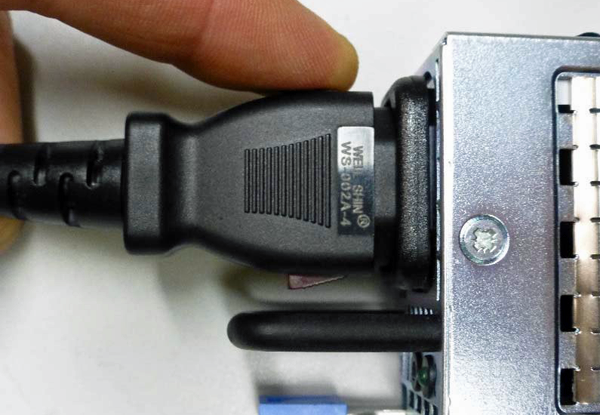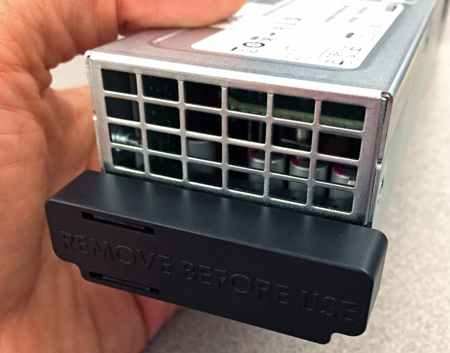This platform supports up to two AC hot
swappable power supplies. Most platforms come with only one power supply by
default.
CAUTION:
Running without
power supplies installed in all available bays in the platform can affect
cooling and electromagnetic interference (EMI). If you need to run the unit
with one power supply unit (PSU), you must install a blank supply bracket into
the empty power supply bay. The blank supply bracket is required to maintain
proper airflow in the system. If you do not have a blank supply bracket, leave
all supplies installed and disconnect power from any unused PSUs.
CAUTION:
Do not mix power
supply unit (PSU) models. If two PSUs are installed in the same system, use
only PSUs of the same model.
Important: This product
is sensitive to electrostatic discharge (ESD). F5®
recommends that you use proper ESD grounding procedures and equipment when you
install or maintain the unit.
Note: The AC
power supply units (PSU) do not
have an on/off switch. You can control the power from the rack switch
.
Note: After removing input
power from any power supply unit, wait 30 seconds before reapplying input
power to the power supply unit.
About AC power supplies
This platform can support up to two AC power supplies. You can hot swap a power
supply without powering down the system if there are two installed, and one
remains installed and operational during the replacement process.
The platform supports power supply redundancy, which ensures that the system is
unaffected if a single power supply fails in a system containing more than one
power supply.
CAUTION:
As a safety
precaution, the socket outlet must be installed near the equipment and be
easily accessible.
Replace an AC power supply in a single-supply
system
In the event of a power supply
failure, you can replace an AC power supply in a single supply system.
CAUTION:
Be
sure that you are using the correct wattage power supply when performing a
power supply replacement.
Note: All photos shown
are examples. The appearance of your components or accessories might vary
slightly.
-
Use the touchscreen LCD to halt and power off the system.
Performing a proper shutdown procedure helps maintain system
integrity.
-
Before removing the PSU from your system, disconnect the AC power
cord from the power supply by pulling one or both of the power cord
locking tabs away from the power supply.
Important: Locking AC power cords might not be available in all countries.
-
Remove the failed AC PSU by squeezing the ejector latch and pulling
straight toward you.
Note: After you remove
a power supply unit (PSU) from the system, ensure that the replacement PSU has
been unpowered for 30 seconds to ensure that the PSU circuitry is fully
discharged before inserting the replacement PSU into the system.
-
If a connector protective cap is installed on your new PSU, remove it
prior to installing the PSU into your system.
-
Inspect the new PSU, especially the connector area, for any damage
that might have occurred during shipment.
-
Slide the new PSU into the empty slot, and push it in until the
ejector latch engages and clicks.
Note: While installing
the supply, use care to ensure that the supply's connector does
not come into contact with the rear of the chassis.
-
Ensure that the PSU is fully seated in the chassis by making sure it
does not come out when gently pulled.
-
Connect an auto locking AC power cord to the power input panel on the
new PSU.
Note: Be sure to route the power cords away from the fan
tray so that the cords do not impede access to it.
-
Connect the power cord to the power source.
If the system does not boot after you apply power to the PSU, use
the touchscreen LCD to power on the system.
-
Optional:
Use the LCD touchscreen to clear any alert messages that might have
resulted from performing the PSU replacement.
Replace an AC power supply in a dual-supply
system
In the event of a power supply
unit (PSU) failure, you can replace an AC PSU in a dual-supply system without
powering down the system, provided that there is at least one PSU operating
during the replacement process.
CAUTION:
Be
sure that you are using the correct wattage power supply when performing a
power supply replacement.
Note: All photos shown
are examples. The appearance of your components or accessories might vary
slightly.
-
Make sure that you have a live power supply unit (PSU) already
installed in your system if you want to hot swap a PSU while the
system is running.
-
Before removing the PSU from your system, disconnect the AC power
cord from the power supply by pulling one or both of the power cord
locking tabs away from the power supply.
Important: Locking AC power cords might not be available in all countries.
-
Remove the failed AC PSU by squeezing the ejector latch and pulling
straight toward you.
Note: After you remove
a power supply unit (PSU) from the system, ensure that the replacement PSU has
been unpowered for 30 seconds to ensure that the PSU circuitry is fully
discharged before inserting the replacement PSU into the system.
-
If a connector protective cap is installed on your new PSU, remove it
prior to installing the PSU into your system.
-
Inspect the new PSU, especially the connector area, for any damage
that might have occurred during shipment.
-
Slide the new PSU into the empty slot, and push it in until the
ejector latch engages and clicks.
Note: While installing
the supply, use care to ensure that the supply's connector does
not come into contact with the rear of the chassis.
-
Ensure that the PSU is fully seated in the chassis by making sure it
does not come out when gently pulled.
-
Connect an auto locking AC power cord to the power input panel on the
new PSU.
Note: Be sure to route the power cords away from the fan
tray so that the cords do not impede access to it.
-
Connect the power cord to the power source.
If the system does not boot after you apply power to the PSU, use
the touchscreen LCD to power on the system.
-
Optional:
Use the LCD touchscreen to clear any alert messages that might have
resulted from performing the PSU replacement.








